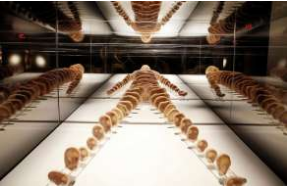Week 2: Math + Art
In Edwin Abbott’s Flatland, Abbott describes that the
shapes of an object that we optically perceive change with one’s perspective. He specifically uses an example of a penny
sitting upon a table to express how it could be seen as a line, circle, or oval,
depending upon the viewer’s angle (Abbott 2).
While Abbott’s view is certainly correct, he is not the first to have
conceived the idea of perspective, or linear perspective, in art.
Mathematics really
began to influence the work of artists during the Renaissance, with artists
intensely studying optics and light.
Brunelleschi, in particular, utilized basic geometry in the forms of
triangles and rectangles, and embraced perspective (PBS.org). Leonardo da Vinci further built upon
Brunelleschi’s principles of perspective and geometry, as can be seen by the
uses of vertices and a vanishing point in The
Last Supper (LeonardoDaVinci.net, Frantz).
The idea of math
in art by utilizing linear perspective and simple geometric shapes is still
seen today. For example, Sonia Sheridan’s Generative Systems work. Looking specifically at her first work of art
on diffraction, one can easily see the inclusion of linear perspective,
triangles, and rectangles, in the doorway.
Moving on to her second diffraction piece, the usage of basic geometric shapes
in art is exemplified. While the work seems
to be a bunch of circles, close inspection shows that the larger circles below
are “shaded” by lines that create very small squares; so the circles are made
up of hundreds of tiny rectangles.
Prior to this
week, I had always thought that certain artists tried to just do their best in
recreating the natural world in 2D works. I had not considered the studious
nature that many go through in attempting to match their works with real world
mathematics and geometry, utilizing linear perspective and the golden
ratio. These artists are able to express
themselves not only through the art that they create, but also through the
mathematical principles that they choose to base their masterpieces on.
Mathematics,
science, and art are clearly connected, through some of the features mentioned
above. After this week’s lecture and
readings, I personally would have trouble juxtaposing art, science, and
mathematics, since I do not believe that these three categories are necessarily
separate and can be compared to one another, as they interrelate so closely.
References:
Abbott, Edwin A. Flatland. London, Seeley & Co., 1884.
Abbott, Edwin A. Flatland. London, Seeley & Co., 1884.
“Filippo Brunelleschi.” PBS,
Public Broadcasting Service, 2017, www.pbs.org/empires/medici/renaissance/brunelleschi.html.
Accessed 14 Apr. 2017.
Frantz, Marc. Vanishing
Points and Looking at Art. 2000.
Sheridan, Sonia
Landy. Generative Systems: Art & Science. 2003,
www.sonart.org/book/chapter07/chapter.htm. Accessed 14 Apr. 2017.
“The Last Supper -
by Leonardo Da Vinci.” The Last Supper - by Leonardo Da Vinci,
2017, www.leonardodavinci.net/the-last-supper.jsp. Accessed 14 Apr. 2017.






Comments
Post a Comment